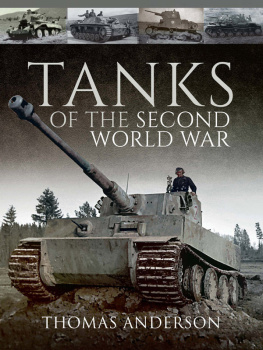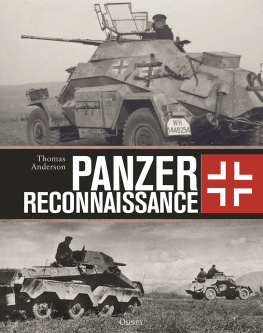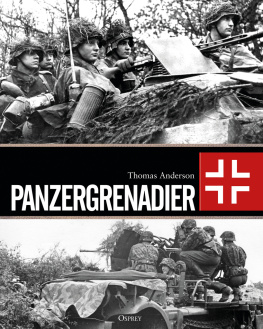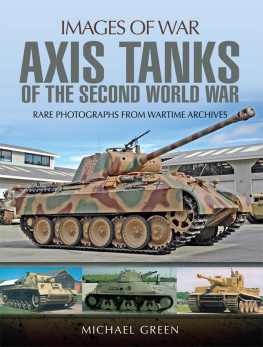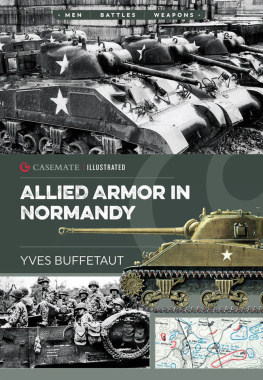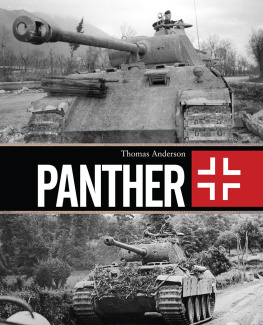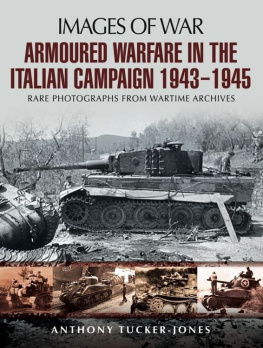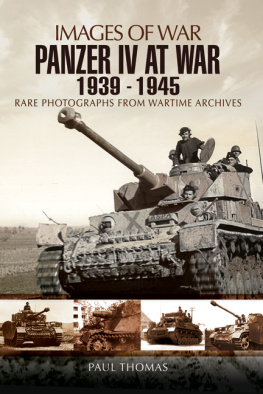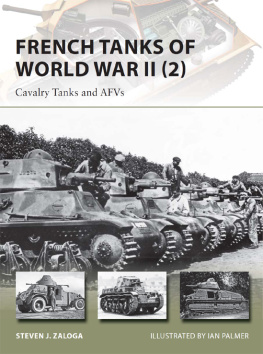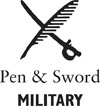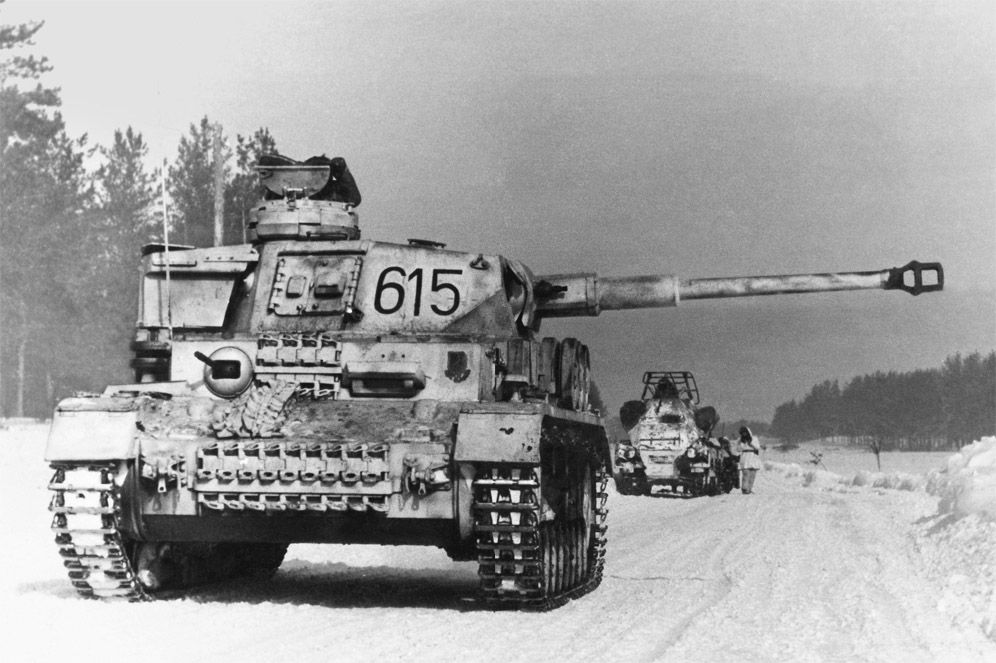
A PzKpfw IV Ausf.G (German Mk IV, G version) protects the flank while an armoured reconnaissance vehicle (SdKfz 263) is repaired. The MK IV long-barrel was one of the most important German battle tanks and remained operational until the wars end. This Panzer was attached to 1.SS-Panzer Division Leibstandarte. Wilhelm
Tanks of the Second World War
Thomas Anderson
(translated by Geoffrey Brooks)
Acknowledgements
I thank the following persons who helped me with the photographic material (for the most part not previously published):
Florian von Aufsess, Germany
David Doyle, USA
Darren Neely, USA
Daniele Guglielmie, Italy
Fraser Gray, England
A.Baumller, Germany
Henry Hoppe, Germany
Karlheinz Mnch, Germany
Wolfgang Schneider, Germany
Joachim Baschin, Germany
Lutz Konetzky, Germany
Markus Zllner, Germany
Yuri Pasholok, Russia
Akura Takahashi, Japan
Further photos were obtained from NARA, Washington and the Library of Congress, the Bundesarchiv, HistoryFacts, Signal Corps, Ullstein, Kadari, Netrebenko, Bumller, Schneider and Erdmann.
First published in Great Britain in 2017 by
Pen & Sword Military
an imprint of
Pen & Sword Books Ltd
47 Church Street
Barnsley
South Yorkshire
S70 2AS
Copyright Thomas Anderson 2017
ISBN 978 1 47385 932 6
eISBN 978 1 47385 934 0
Mobi ISBN 978 1 47385 933 3
The right of Thomas Anderson to be identified as the Author of this Work has been asserted by him in accordance with the Copyright, Designs and Patents Act 1988.
A CIP catalogue record for this book is available from the British Library
All rights reserved. No part of this book may be reproduced or transmitted in any form or by any means, electronic or mechanical including photocopying, recording or by any information storage and retrieval system, without permission from the Publisher in writing.
Pen & Sword Books Ltd incorporates the imprints of Pen & Sword Archaeology, Atlas, Aviation, Battleground, Discovery, Family History, History, Maritime, Military, Naval, Politics, Railways, Select, Transport, True Crime, Fiction, Frontline Books, Leo Cooper, Praetorian Press, Seaforth Publishing and Wharncliffe.
For a complete list of Pen & Sword titles please contact
PEN & SWORD BOOKS LIMITED
47 Church Street, Barnsley, South Yorkshire, S70 2AS, England
E-mail:
Website: www.pen-and-sword.co.uk
Photo credits: All photographs have been supplied from the authors comprehensive collection and by Sky Gallery International Aviation Photography

An M4 Sherman fitted as a rocket lancher. 60 barrels (116 mm diameter) were mounted in a simple firing frame directly on the unmodified armoured turret. This solution was used only in the Second World War. NARA
Tank Warfare!
The battlefields of the Second World War were dominated by the tank. Their use gave rise to a strategy unknown until then. Protected by its armour, the highly manoevrable vehicle could roll up to enemy trenches and cross over. Its armament could silence the enemy defences and enable its own infantry to follow with minor losses, taking advantage of the local success gained. What were the tanks origins? How did the tank develop up to the time of the second catastrophe of the 20th century? And how did this development fare under the spell of the mechanised battles of the Second World War?
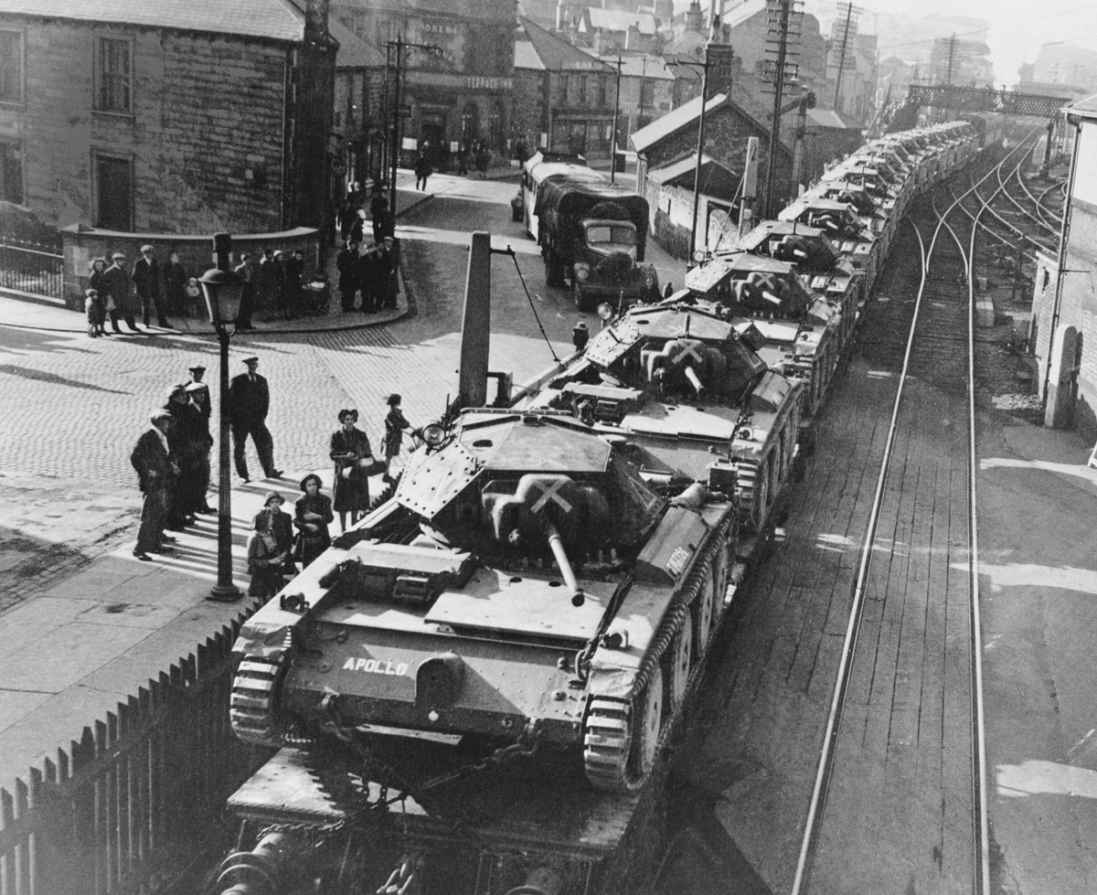
British Cruiser Mk V Covenanter tanks on a rail transporter. More than a thousand of the type were produced, but only used for training in England. A rather unusual characteristic was the air cooler for the motor, located left near the driver. (Library of Congress)
The German word Panzer (armour) comes from the Middle High German pancier, (armament for the body), a word borrowed from the French panciere (paunch), which comes from the Old French pance , and that in its turn from the Latin pantex (paunch).
In the areas where the German language is spoken, the word Panzer (tank) has a negative ring. For the postwar generation the tank, more than any other weapon, is representative of the cruelty of war, for violence and death. It is not my purpose to criticise this attitude nor doubt it. War is the greatest catastrophe which one people can inflict upon another.
Technical progress brought humanity definite improvements. It helped to control outbreaks of disease, to cure illness and prevent famine. Warfare, however, changes things fundamentally. The great physicist Albert Einstein was very pessimistic in his opinion:
I am not certain with what weapons the Third World War will be fought, but the Fourth World War will be fought with sticks and stones.
His pessimism was based on his great understanding of people. Progress alone cannot change the way people are. It is up to ourselves to prevent wars or effectively suppress them.
It is the purpose of historical research to throw light on every facet of cultural development. This research must be objective and value-free. It should never allow itself to become an instrument of political influence no matter in what form that may be presented. War research is too dangerous to be left in the hands of nostalgic Nationalists or Utopian dreamers.
This book attempts to trace the development of the tank in the Second World War whilst adhering as closely as possible to the historical facts. The development of the tank by the industries of the various States is treated chronologically. The principal tanks considered are those built to confront their enemy counterparts. This clear division is not always successful.
An understanding of the subject would not be complete without prior reference to the tanks which made their first appearance in the Great War 1914-1918, and the subsequent dynamic development in the inter-war period. This requires a look at individual tanks both in isolation and in comparison. Reducing particular tanks to their theoretical values is only part of the story, for important influences of scale such as the quality of strategic and tactical command, technical reliablity or essential parameters including the types of ammunition, fuel and spare parts have to be left aside.
War is not a computer game and the pure comparison of technical details can be misleading. A good example of this is the effectiveness of tank guns. In 1941 Germany was developing guns capable of delivering very powerful ammunition. The 7.5 KwK 42 L/70 of the German Panther could fire the conventional AP shell PzGr 39/42 to penetrate 111-mm armour steel at 1,000 metres. The improved version PzGr 40/42 shell could penetrate 150 mm armour. These shells had a tungsten core which gave better penetration on account of their temper. Tungsten was a scarce material in the German Reich, and the small quantities available did not allow a reliable supply. Also available was the hollow charge shell Gr 39 Hl which could penetrate armour at 90 mm within range. At impact a metal spike penetrated the armour independent of the speed of impact and range. Hollow charge shells were not highly explosive and their accuracy was variable. Original reports show that for this reason a Panther commander would generally prefer the PzGr 39/42. The penetrative achievements provided in the descriptive tables of tank types are therefore an indication depending on other factors.

